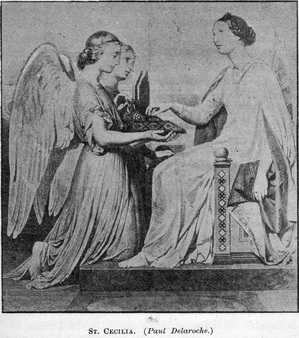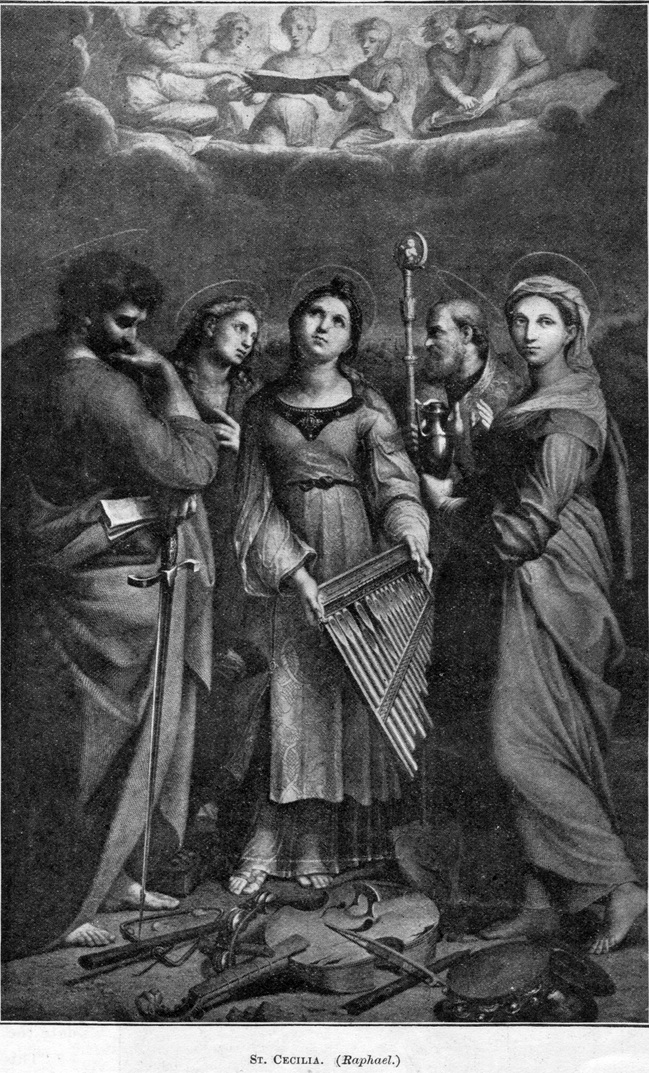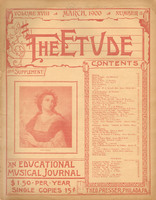BY FANNY MORRIS SMITH.
Among the saints of the poet’s calendar none is more universally sung than St. Cecilia; her church and academy in Rome still attest her graces. She is the only saint in England, except St. George, that has entered into English literature and art as a formative element. France and Germany are full of societies named in her honor, and celebrating her praise on her own particular day, November 22d. As a saint little is known of her history, and that little is much disputed.
The church built over Cecilia’s house has been perpetuated in a series of edifices until to-day, but the name of Cecilia does not appear in the list of Roman martyrs during the third century. To remedy this, Cecilia’s martyrdom has been referred to Sicily, between a.d. 176 and 180; but this is not as well supported as the former version.
Pope Symmactius, a.d. 499, mentions the Roman church which was rebuilt in 824 by Paschal, who was informed by the saint in a dream where to find her body. He exhumed it and those of Valerianus Tiburtius, and Maxuman and nine hundred maidens and deposited them all in the new church, as objects of worship. In 1591 Cardinal Sfondrati, nephew of Gregory XIV, again rebuilt the edifice, from which church he derived his title of cardinal, a dignity still represented in the Roman College of Cardinals. In all this time no hint of Cecilia’s future career as tenth muse appears.
She is made to speak of a guardian angel who forbids her marriage in Chaucer’s poem; but she does not sing, much less play the organ, and for the excellent reason that there were no organs in a.d. 230. The little manual attached to a few pipes and played with one hand, with which Van Eyck and his contemporaries represent her was a production of the centuries immediately preceding the renaissance.
The musical character of Cecilia must be sought elsewhere in the survival of prechristian popular customs.
When Europe was Christianized it was a comparatively easy task to persuade the population to accept the Christian dogmas; the thing that proved impossible was to eradicate the system of holidays, merrymakings, and pageantry that the earlier religion had grouped about the solar myths. These the population persisted in; under what name did not matter, so that the festivals were preserved. It is to the survival of old customs among the Celtic races that we must search for the origin of Cecilia’s musical character, for about the middle of the sixteenth century, it appeared that in France, in Switzerland, in England, singing competitions were universally held on November 22d, which happened to be Cecilia’s Day. That is to say, the popular custom, which had persisted unnoticed for centuries with the development of music, suddenly came to the surface in countries widely separated in government, language, and manners.
 St. Cecilia did not obtain her recognition without a struggle. The very first record of her association with music shows that a certain society in Louvain, in 1502, thought of naming itself after St. Job, but the local magistrate decided in favor of St. Cecilia. The earliest St. Cecilian society of which we have definite information is Le Puy de Musique, 1571, at Evreux, in Normandy. A solemn celebration of vespers and complin took place on the evening of the vigil; high mass, vespers, and complin were performed on the feast-day; and a requiem mass for the souls of the departed founders on the morrow. A banquet was given after mass on the feast-day, and prizes were awarded for the best molets, part songs, airs, and sonnets. Such great composers as Orlando de Lasso and Eustache du Caurroy were prize-winners in these competitions.
St. Cecilia did not obtain her recognition without a struggle. The very first record of her association with music shows that a certain society in Louvain, in 1502, thought of naming itself after St. Job, but the local magistrate decided in favor of St. Cecilia. The earliest St. Cecilian society of which we have definite information is Le Puy de Musique, 1571, at Evreux, in Normandy. A solemn celebration of vespers and complin took place on the evening of the vigil; high mass, vespers, and complin were performed on the feast-day; and a requiem mass for the souls of the departed founders on the morrow. A banquet was given after mass on the feast-day, and prizes were awarded for the best molets, part songs, airs, and sonnets. Such great composers as Orlando de Lasso and Eustache du Caurroy were prize-winners in these competitions.
During the early centuries of Christianity it was the invariable custom of the villagers to assemble in the church-yard on all the saints’ days and spend the afternoon and evening in dancing and singing,—the clergy often assisting and partaking in the festivities.
Nothing strange appears in the festival of Evreux, therefore. The church preceded the original feast by mass, and then adopted it thus regenerated into her own ritual. The peculiarity is that, in the final selection of a special music day, the 22d of November should have been selected, and this could, I believe, be traced to an antecedent habit of holding trials of skill in music on that date.
Welsh and Celtic nations generally delighted in such trials of skill, and Wales held, and still holds, them annually. Such music festivals were held all over Europe wherever Celtic minstrelsy penetrated, and where did it not?
But as to the historical connection with Cecilia herself, the founding of the Accademia St. Cecilia, at Rome, by Palestrina, may have been the turning-point.
The Guild of Minstrels in France was not under the patronage of Cecilia, but of St. Julien.
The “Society of Artist Musicians” at Paris, about the middle of the nineteenth century, had a custom of having a high mass performed at St. Eustache on St. Cecilia’s Day, for which occasion Adolph Adam, Niedermeyer, Dietsch, Gounod, and Ambroise Thomas wrote masses.
Ireland, Scotland, Germany, and Italy have also held such celebrations. Spohr composed a hymn to St. Cecilia, and so did Moritz Hauptman. The participation in the Cecilian cult of the most highly educated class of musicians in each of these countries points to an aristocratic origin of the Cecilian program; in every case a great musical occasion was attempted, precisely as in Wales to-day.
St. Cecilia’s Day did not dawn in England until nearly the end of the seventeenth century. The first series of annual celebrations known to have been held there was initiated in 1683, in London, by the Musical Society. After divine service, usually attended at St. Bride’s Church, which included a choral service and anthem with orchestral accompaniments often composed for the occasion and performed by a large body of musicians, the company adjourned to another place, usually Stationers’ Hall, where an ode in praise of music, written and composed for the occasion, was performed, after which the company sat down to a feast.
The fine ode by Dryden is the first of the noble literature to the Christian Muse which England has raised. Shadwell, Congreve, d’Urbey, Addison, and Pope are among her poets; while Purcell, Blow, Draghi, Clarke, Händel, Pepusch, and Boyce have set odes for these festivals.
The Cecilian odes in turn have given rise to that fine series of hymns and descriptive musical poems in which English literature is so astonishingly rich. The English poetry on music is so much finer than contemporary English music itself that it seems to have been fed on yearning. The Cecilian literature of England was noble, pure, and of most delicate insight. English literature of music is not necessarily Greek, but the literature of St. Cecilia herself was thoroughly classical, and sprang directly from the dominion of Greek and Latin studies. The poets that cultivated her fame most assiduously, like Dryden, Addison, and Pope, were the leaders in the classical school. The appearance of the saint on Italian canvas arose from similar conditions of mind,—she is the product of the Italian renaissance, and the poet-artists who gave her visible form were saturated through and through with Greek learning and Greek art.
To the Italian artist, as to the English poet, Cecilia was the muse of music, the heavenly maid, On invocation, apostrophy, and qualifications she occupies the position upon Olympus which none of the original nine filled, because the art she personifies was not created in their day. Cecilia and modern music emerged together from the dark ages—the one art and its personification developed under Christianity and fostered by civilization.
Meantime, while English poets were defining her sphere, the fine arts on the Continent were painting her portrait and crystallizing her character.
Van Eyck was content to paint her with her hand on her organ; Rubens endowed her with the lineaments of his wife, and summoned a troop of Amors to attend her melody. Domenidimo paints a girl, passionate and high wrought, whose song is not hushed, but accompanied by a very stylish Amor, playing the flute. Carlo Dolce omitted the cherub, intent on the beauty of his subjects, while Raphael, on the other hand, drew a woman who, in despair at imitating the heavenly choir on which her eyes are fixed, has broken the favorite musical instruments of her day at her feet. This Cecilia, the transcendentalist, is the genius of modern art, and in drawing her thus Raphael’s insight was prophetic, for Raphael stood at the point where modern music in its newly created forms of opera, oratorio, and instrumental music had just entered the phase of development which has proceeded unbroken till to-day. From Raphael till the year 1900 painters have gone on endowing their feeling for music with human form; the musical atmosphere in which Ary Scheffer lived brought out his superb saint, earnest, wrapt, beautiful; the irreligious art of the century just closed has produced such vanities as the work of La Lyre. German art has reproduced a series of haus-frauen, seated at musical instruments and gazing at their chubby offspring, who depend from the ceilings; all swing content and pretty. There are even dramatic Cecilias perched high on organ stools, playing modern pipe organs to wrapped hearers: the apotheosis of the concert artist. But when all is said and done the small part that woman and saint have really had in the development of the art of music is painfully apparent. They have been the ostensible inspiration, to be sure; but, they have not been inspired. They have not created, they have only listened and admired.
Still the question remains: is St. Cecilia’s art in any way different because she has been erected as its patroness? We must candidly answer: No. But to the converse proportion, Is it because the art of music is purer, nobler, and more sympathetic than any pagan art, even the highest, ever was or could be, that it has won a woman and a saint to be its patroness? We answer: Yes. And the strongest difference between modern music and pagan art is the reason why Cecilia is the muse at all; not because of her sex, but because of her saintliness. She typifies the great truth that modern art, rooted as it undoubtedly is and must be, in the great fact of sex, yet passes out of sex into a play of emotion that covers the whole field of life and of religion, and women set free by the same ennobling development begin to make their way into the arts and callings so long closed to them.
Perhaps the folk-lore society can point out exactly the astronomical event this of Cecilia’s cult has obliterated. But in obliterating it her tradition has been making for the day of women,—women doing their work in the world on even terms, in honor, freedom, and amplitude of power.




